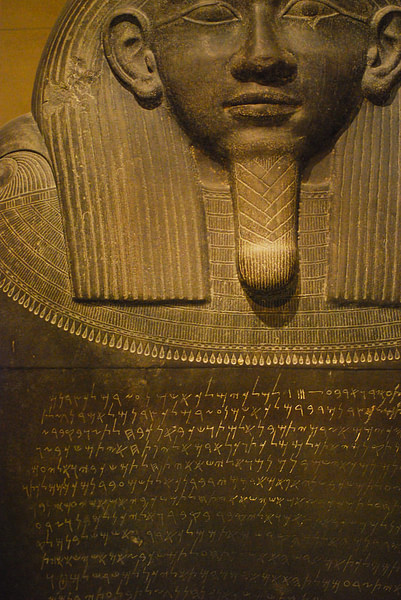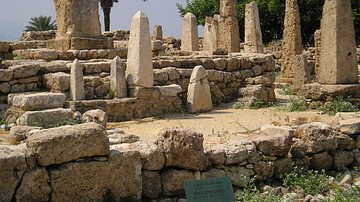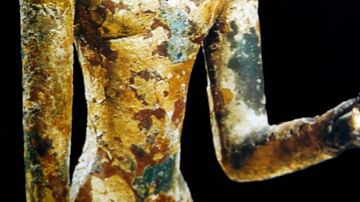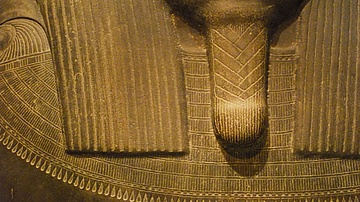
The governments of such Phoenician cities as Tyre, Sidon, and Byblos were led by hereditary monarchs throughout their history. Those individual cities typically acted autonomously from each other and only rarely did they form mutual alliances. The absolute power of the Phoenician kings, even if they had at their disposal a council of elders for consultation, is attested by various ancient sources, including the Hebrew prophets of the Old Testament. Below the king, matters of government were also carried out by a priestly class and those elite households who controlled the international trade upon which Phoenicia so prospered.
A Collection of City-states
Phoenicia was never a single political entity but rather a collection of culturally similar cities on the narrow strip of the Levant. Each city had its own independent system of government, which controlled the city and its surrounding territory. At certain times one city might be more dominant than another in the region but individual autonomy was not perhaps compromised. Sidon dominated in the 12th and 11th centuries BCE while thereafter Tyre was the most powerful Phoenician city. Only very occasionally did one Phoenician city form a formal alliance with another. Even when the cities acted with the same policies, they did so individually. An example is in the 5th century BCE when Phoenician cities contributed ships to the Persian fleet of Xerxes, each group acted under their own commander's orders.
Hereditary Monarchies
Phoenician kings did not commemorate their reigns or achievements in art and inscriptions as in other cultures, and so information is often scarce, not only on the machinery of government but even such basics as who ruled when. We do know from certain tomb inscriptions and scattered sources from other contemporary cultures that the monarchies of the Phoenician cities were absolute in their power until the 7th century BCE. Unlike in other ancient societies where a ruler's wealth was usually acquired through some form of taxation on agricultural production, the Phoenician kings, not having quite so much territory to call upon, acquired their wealth either from directly engaging in trade expeditions themselves or taxing the trade of the city's elite merchants.
The monarchy was usually hereditary, even if there were sometimes revolts, wars, and dramatic changes of dynasty. Marriages of convenience with the royal houses of other cities were also arranged to maintain and increase the king's power. Inscriptions suggest that a long ancestral line was a mark of prestige. From an inscription on the coffin of King Ahiram of Byblos we have the following king list:
- c. 1000 BCE Ahiram
- 980 BCE Ittobaal
- 940 BCE Abibaal
- 920 BCE Yehimilk
- 900 BCE Elibaal
- 880 BCE Shipitbaal
The annals of Tyre and other complimentary sources produce the following list of reigning kings for Tyre:
- 969-936 BCE Hiram I
- 935-919 BCE Baal-eser I
- 918-910 BCE Abdastrato
- 909-898 BCE Methustratos
- 897-889 BCE Astharymos
- 888 BCE Phelles
- 887-856 BCE Ithobaal I
- 855-830 BCE Baal-asor II
- 829-821 BCE Mattan II
- 820-774 BCE Pygmalion
- 750-740 BCE Ithobaal II
- 739-730 BCE Hiram II
- 730-729 BCE Mattan II
- 729-694 BCE Elulaios
- 680-640 BCE Baal I
- Late 7th century BCE but specific dates unknown – Ithobaal III
- Baal II
- Mattan III
- Hiram III
There is no evidence of any queens ruling alone but an inscription at Sidon describes one Queen Unmiashtart who ruled as regent for her son Yatonmilk during the 5th century BCE. There is one other strong female leader mentioned in sources, the semi-mythical figure of Dido, sister of Pygmalion, the king of Tyre. Disgruntled with her brother's policies she is said to have collected a group of like-minded nobles and left Tyre to found her own city, Carthage, on the north coast of Africa.
The Priesthood
Another class was the priests who tended the temples and performed rituals, once again, members would have come from the royal family and leading merchant families. There was sometimes a direct connection between the royal and priestly class, for example, Ozbaal, king of Byblos was the son of Paltibaal, the priest of Baalat, according to an inscription on his coffin. The monarch also had a priestly function, perhaps even holding the position of high priest and one of the king's secondary titles was 'Priest of Astarte'. Perhaps not unconnected with this fact, kings were keen for their deeds to match their frequently used additional titles of 'just' and 'righteous' by building temples and monuments in honour of deities such as Astarte, Baal, and Melqart. It is also true that some kings conveyed the idea of being the god's representative in their very name, for example, Baalbazer which signifies 'servant of Baal' or Abdastratus, 'servant of Astarte'. Some kings must have gone one step further and claimed to have actually been the god on earth, a claim much criticized by the Hebrew prophets, as seen in the book of Ezekial in the Bible.

Senior Officials
The king of Tyre could consult a council of elders for advice but it is not known if this body met regularly to discuss policy or what its powers were. According to the ancient historian Arrian, the council could make decisions if the king was otherwise unavailable. The book of Ezekial mentions 'ancients' in the court of Byblos, which could well refer to a similar council. Finally, Diodorus, the 1st-century BCE historian, describes a council of 100 members at Sidon, mentioning that they sometimes took decisions contrary to those of the king. The membership of these councils was likely reserved for members of the royal family and those senior merchants who controlled the trade activities of the city.
Below the king were two specific positions of importance - the governor and the commander of the army. The former was responsible for supervising the court and city administrations. The title is mentioned in texts from Ugarit, El Amarna, and Cyprus, but once again, details are lacking.
Alternative Forms of Government
There is mention in the annals of Tyre of a peculiar if brief period of government during the 6th century BCE when the city was ruled at any one time by a pair of judges known as suffetes. Later, this system would be adopted by Carthage. When the Phoenician cities came under Assyrian domination in the 7th century BCE, the king had to rule alongside an Assyrian governor who guided policy. The king could not even open official correspondence without being in the presence of this governor. An exception to this dual governance was at Simira where there was not even a king and the Assyrian governor ruled alone. A similar arrangement existed in the 6th century BCE when the Babylonian king Nebuchadnezzar II imposed a minister to co-rule with the king at Tyre and again under the Persian domination of the following century.





